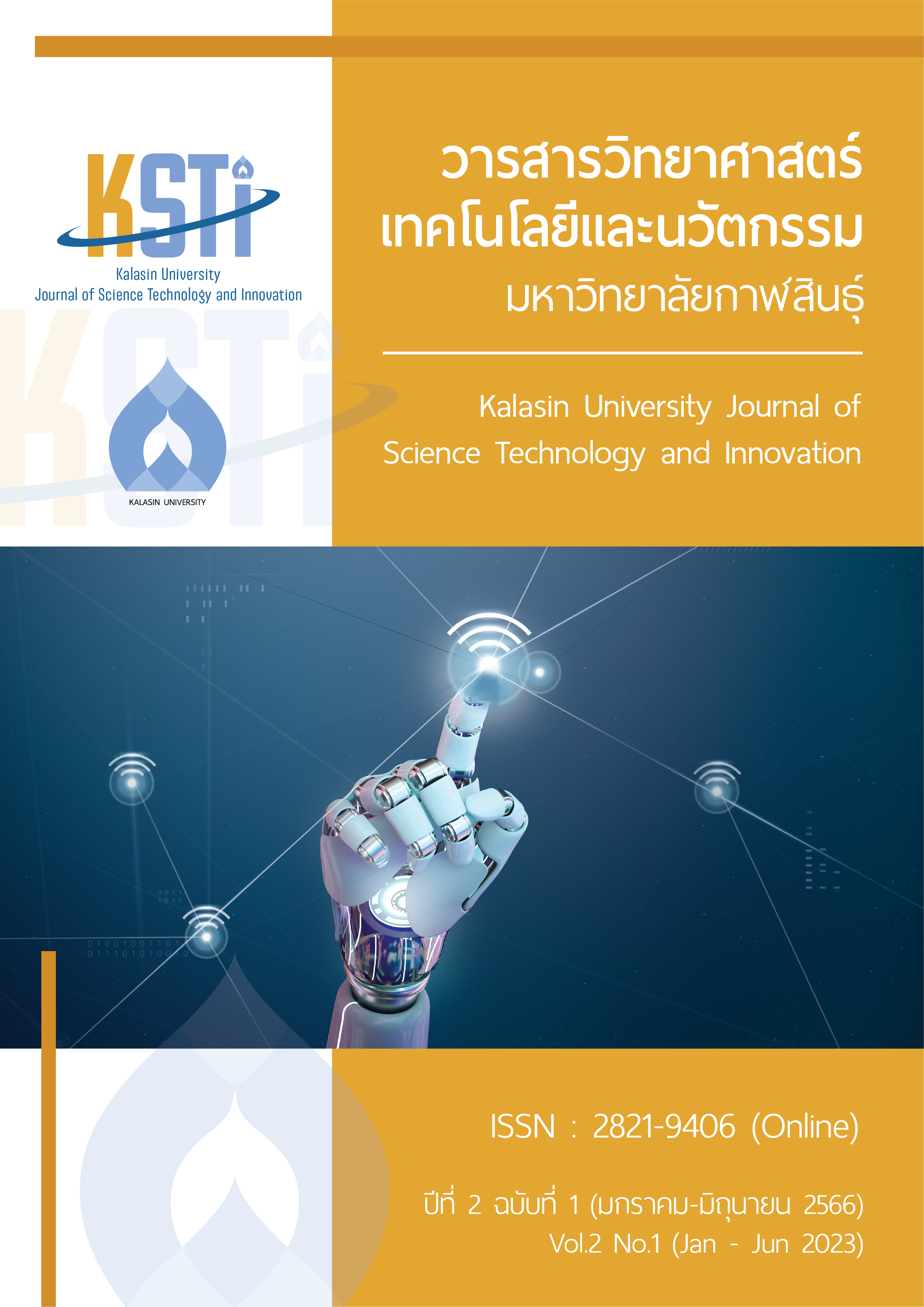The Effectiveness of Machine Learning Forecasting of PM2.5
Main Article Content
Abstract
The purpose of this research was to compare the efficiency of machine learning techniques to predict small dust particles in the air (PM2.5). The 16 variables were used to construct PM2.5 dust models from air quality and meteorological measurement stations of the Pollution Control Department that was collected an hourly format during June - December 2021, a total of 4,608 rows. The data analysis process is to build a trend prediction model of small dust particles in the air with data estimation techniques (Regression Model). Four different machine learning techniques were used as linear regression, neural networks, support vector machines, and deep learning. The results show that the most suitable technique for modeling dust particles in the air prediction is the neural network technique with the least mean squared error (MSE) of 8.673, the mean squared error (RMSE) of 2.945, the absolute error (AE) of 2.126, the doubled squared error (SE) of 8.709, and the multiple decision coefficient (R2) of 0.948. The results can be used to build a suitable model for trend prediction of small dust particles in the air and set a standard scale for fine particulate matter in the air. Including, the relevant organizations can access the information and used to determine measures to monitor the occurrence of small dust particles. The results can also be further developed an information system for predicting small dust particles to appear in the air more accuracy.
Downloads
Article Details

This work is licensed under a Creative Commons Attribution-NonCommercial-NoDerivatives 4.0 International License.
The owner (Research and Development Institute, Kalasin University), the authors agree that any copies of the article or any part thereof distributed or posted by them in print or electronic format as permitted will include the notice of copyright as stipulated in the journal and a full citation to the final published version of the contribution in the journal as published by Research and Development Institute, Kalasin University.
References
DAIKIN THAILAND. PM2.5 คืออะไร? อันตรายและการป้องกันฝุ่นละอองขนาดเล็ก [อินเทอร์เน็ต] 2563. [เข้าถึงเมื่อ 25 มีนาคม 2566]. เข้าถึงได้จาก: https://www.daikin.co.th/service- knowledge/pm-2-5/
เวชกร ไกรยราช, ภัทรพงศ์ บัณฑฺตา. แอปพลิเคชันพยากรณ์ปริมาณฝุ่นละอองขนาดเล็กในอากาศ PM2.5 ด้วยโครงข่ายประสาทเทียม (ปริญญานิพนธ์ปริญญาวิทยาศาสตรบัณฑิต). คณะวิทยาการสารสนเทศ. มหาสารคาม:มหาวิทยาลัยมหาสารคาม; 2564.
บรรจบ ชุณหสวัสดิกุล, พยงค์ วณิเกียรติ, อัมพร กรอบทอง, กมล ไชยสิทธิ. ผลต่อสุขภาพของฝุ่นละอองในอากาศขนาดไม่เกิน 2.5 ไมครอน กลไกก่อให้เกิดโรค และการรักษาด้วยการแพทย์ทางเลือก. วารสารการแพทย์แผนไทยและการแพทย์ทางเลือก. 2563; 18(1): 187-202.
อินท์ฉัตร สุขเกษม. การพยากรณ์ปริมาณฝุ่นละอองขนาดไม่เกิน 2.5 ไมครอน (PM2. 5) จังหวัดนครราชสีมา. The office of disease prevention and control 9th Nakhon Ratchasima Journal. 2021; 27(1): 16-25.
ธรณินทร์ สัจวิริยทรัพย์. ตัวแบบผสมอารีมา-ซัพพอร์ตเวกเตอร์แมชชีนเน้น องค์ประกอบเชิงบวกสำหรับการพยากรณ์ปริมาณฝุ่นละอองขนาดไม่เกิน 10 ไมครอน. Thai Science and Technology Journal. 2019; 27(3): 526-538.
พรนภา แสงศรี, พรพิมล ชัยวุฒิศักดิ์. วิธีผสมของโครงข่ายประสาทเทียมและห่วงโซ่มาร์คอฟสำหรับพยากรณ์ปริมาณ ความเข้มข้นของฝุ่นละอองขนาด 2.5 ไมครอน. Thai Science and Technology Journal. 2021; 29(5): 752-765. doi: 10.14456/tstj.2021.63.
ชญานนท์ เทพแสงพราว, ธงทิศ ฉายากุล, ศิริมา ปัญญาเมธีกุล. การทํานายปริมาณฝุ่นละอองขนาดไม่เกิน 2.5 ไมครอนจากข้อมูลความลึกเชิงแสงของอนุภาคแขวนลอยในอากาศและข้อมูลอุตุนิยมวิทยาในพื้นที่กรุงเทพมหานครและปริมณฑล. ใน: รายงานการประชุมวิชาการวิศวกรรมโยธาแห่งชาติ ปีที่ 26, 23-25 มิถุนายน 2564 การประชุมรูปแบบออนไลน์: หน้า SGI-02-1 - SGI-02-8.
ปรัชญา สิงหวรวงศ์. การพยากรณ์ฝุ่น PM2.5 ล่วงหน้าในจังหวัดเชียงใหม่ โดยใช้แบบจำลองหน่วยความจำระยะสั้นแบบยาว (สารนิพนธ์ปริญญาวิทยาศาสตรมหาบัณฑิต). คณะวิทยาศาสตร์. นครนายก: มหาวิทยาลัยศรีนครินทรวิโรฒ; 2563.
อนุพงศ์ สุขประเสริฐ, คู่มือการทำเหมืองข้อมูลด้วยโปรแกรม RAPIDMINER STUDIO. พิมพ์ครั้งที่ 4. มหาสารคาม: คณะการบัญชีและการจัดการ มหาวิทยาลัยมหาสารคาม; 2564.
World Health organization. WHO guidelines for air quality [อินเทอร์เน็ต]. 2565. [เข้าถึงเมื่อ 25 พฤศจิกายน 2565]. เข้าถึงได้จาก: https://www.who.int/news-room/feature-stories/detail/what-are-the-who-air-quality-guidelines
จิรายุทธ เจริญ, สิทธิเดช สารจันทร์, อนุพงศ์ สุขประเสริฐ, ธัญญธร ศรีวิเชียร. การพยากรณ์ราคาสกุลเงินอีเธอเรียมด้วยวิธีการเรียนรู้ของเครื่อง. ใน: รายงานการประชุมวิชาการระดับชาติเครือข่ายวิจัยสถาบันอุดมศึกษาทั่วประเทศ ครั้งที่ 15, 26-28 เมษายน 2565 กรุงเทพฯ: หน้า 196–208.
กิตติญา หมุนไหม. โปรแกรมแปลงภาพเป็นคำบรรยายภาษาไทยอัตโนมัติ [อินเทอร์เน็ต]. 2563. [เข้าถึงเมื่อ 25 มกราคม 2566]. เข้าถึงได้จาก: https://shorturl.asia/8gROl.
รณชัย ชื่นธวัช. “การพยากรณ์ค่าความเข้มข้นของฝุ่นละอองขนาดเล็กไม่เกิน 10 ไมครอนด้วยเครือข่ายประสาทเทียมร่วมกับรูปแบบออโตรีเกรสซีพ,”.วารสารวิทยาศาสตร์บูรพา ปีที่ 22, ฉบับที่ 3 (กันยายน–ธันวาคม พ.ศ. 2560), 519-537.


